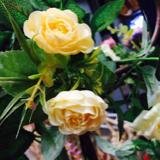
上传成功
举报
转发
2017年08月09日

[图片]#兰花 的浇水方法:
每个兰友都有自己的浇水方式,大部分人通常使用的浇水方法,那就是浇水不仅要根据兰盆的不同和植料的不同,还需要根据天气的变化和兰苗的生长情况而灵活运用。
下面用小编喜爱的打油诗写给各位兰友,仅供参考。
兰花浇水需“四看”,一看兰盆二看料,三看气候四看苗。
一看兰盆:不管兰具盆大小,紫砂塑盆都不孬,透气强弱盆多种,易干盆小勤易浇。
二看植料:兰花浇水看植料,透水较强易常浇,植料不同难定日,勤看兰土再看苗。
三看天气:夏炎冬寒温差高,阴雨气候特重要,季节不同非对待,天气决定何时浇。
四看兰苗:兰株强弱苗多少,壮弱兰草非同浇,苗多旺盛吸水快,需水较少病弱苗。
...显示更多
文章
举报
转发
2017年08月09日

1、栽培#兰花 的环境应通风良好,空气湿润,无污染。兰盆要选择高盆.上粗下细,具有多排水孔,或盆壁设有排水孔。
2、兰花栽培中应不断剪去枯黄老叶和病虫叶,以利通风。花芽出土之后,每株应留一壮花芽,其余剪去,以免消耗过多养分,影响来年开花。花谢后,应将花薹剪除。
3、热季浇水,应在傍晚太阳下山后,以免叶面之水分经太阳照射后灼伤,并防止高温水液浸伤新芽下端幼嫩部分。
4、寒季浇水应在白昼进行,以免夜间盆内有水分冻伤兰根,特忌兰心积水,易使幼株腐烂。
5、兰株叶片有病斑时,要保持叶面干燥,防止病菌蔓延。
6、要注意浇水不要太勤。兰花对水的宽容度是很大的,是比较耐旱的植物,略干一点影响不大。相反湿了可不行,积水24小时就会造成窒息,日常栽培中,绝大多数人是爱兰太甚,浇水太勤,造成根部腐烂,以致植株死亡。
...显示更多
文章
举报
转发
2017年08月09日

在#兰花 冬季的养护过程中,光照是非常重要的一个环节,万物生长靠太阳,兰花也不例外。下面,我们就一起去学习兰花在冬季的养护方法吧!
[图片]兰花冬季的养护方法:
冬季的光照很重要,中原地区每年11月份左右就进入了深秋,这个季节,大部分植物都已停止生长进入了休眠期,兰花也不例外。
其实,兰芽在每年的秋季就已经形成了,要经过一冬的孕育,到春季才破土而出。
进入冬季,表面看兰花已经停止生长,进入休眠期,其实在兰盆的内部却不断的发生着细微的变化,芽点和假鳞球在不断的膨大,兰根也在缓慢的生长。这时不但要让兰叶接受全光照,兰盆也要接受太阳光的直射。这样才能提高盆内温度,促进光和作用,让兰芽和假鳞球蓄积更多的养分,更加茁壮。
[图片]这样经过一冬的孕育,兰芽已为春季的出土做好了充分的准备,一旦进入春季,厚积而薄发,将势如破竹,不但发芽早,更易发壮苗。
在中原地区自然条件下一年发两代壮苗不成问题,由于小编的兰房南边是一段2米多高的围墙,进入冬季由于太阳光的斜射,靠南边的部分兰花见不到阳光,于是每年11月至次年4月,小编就将北边的兰架改成阶梯状,这样兰盆就能充分的接受阳光的直射,小编曾做过测试,见光盆和不见光的盆白天盆内的温度相差3到5度。由于是玻璃房,见到阳光房内升温很快,所以不论白天和夜晚,只要最低温度不低于0度,小编都将窗户开启一小部分,这样不但保持通风,还能控制白天温度不至升的太高,夜晚的温度能够降下来,拉大温差。
这样经过充分的春化和充分的阳光直射,兰花为下一年的生长打下了良好的基础。
...显示更多
文章
滚动加载更多...
article






